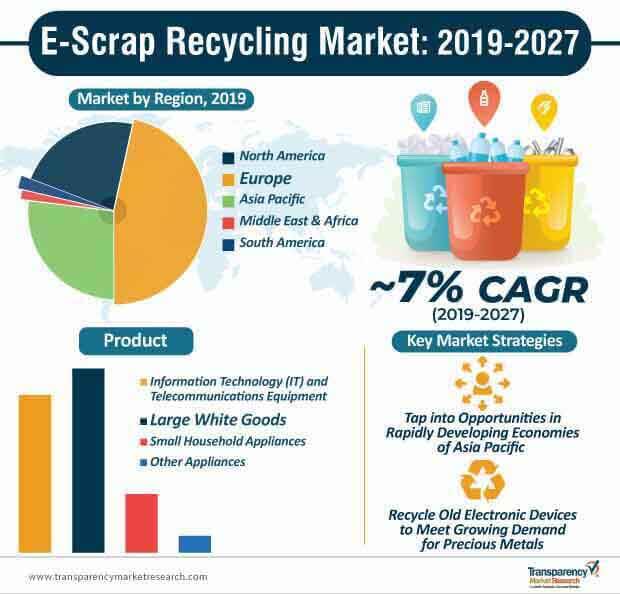
After Europe, Asia Pacific is projected to maintain its position as the second-highest region in terms of recycling volume, with an estimated output of ~5,200 thousand metric tons in the e-scrap recycling market by the year 2027. Since India is one of the rapidly developing economies in Asia Pacific, manufacturers are increasing their focus in the region. As such, there is growing demand for a well-designed and well-regulated e-waste recovery regime in India, as the country is highly deficient in terms of precious metals. Hence, companies in the electronic scrap recycling market can tap into incremental opportunities in India and gain profits, as labor is relatively cheaper in comparison with developed economies.
According to the Global E-Waste Monitor 2017, India generates ~2 million tons of electronic waste, annually, and ranks fifth amongst the e-waste producing countries on a global level. A significant amount of e-waste either goes to landfills or is recycled in a crude manner at informal recycling installations. Thus, companies in the e-scrap recycling market are complying with the Extended Producer Responsibility (EPR) guidelines of environmental commissions in India to ensure the take-back of end-of-life products.

Request a sample to get extensive insights into the E-Scrap Recycling Market
Recycling Precious Metals Leads to Untapped Opportunities in Product Offerings
With the influx of digitization, an increasing number of individuals are purchasing intelligent electronic devices such as smartphones and gadgets. Thus, the increasing adoption of electronic devices has created a load on companies in the e-scrap recycling market to ensure the safe recycling of devices while abiding to the regulations laid down by various governments.
As such, companies in the electronic scrap recycling market are gaining headway out of the situation in acquiring precious metals from discarded electronic devices. Since electronic devices contain components made from precious metals such as silver, copper, gold, and palladium, companies are recovering these metals to develop other new consumer products. For instance, key players are eyeing the 2020 Tokyo Olympics, as the organizing committee is planning to make medals out of e-waste.
Metal in the e-scrap recycling market is projected to account for the highest revenue, with a value of ~US$ 17.6 billion by the end of 2027. This is why, companies are teaming up with device manufacturers to develop new products from e-scrap, as developing products from virgin sources leads to an increased carbon footprint.
To understand how our report can bring difference to your business strategy, Ask for a brochure
Collaborating with Non-profit Trade Associations Helps Companies
Companies in the e-scrap recycling market are facing several challenges that are negatively affecting market growth. Exporting e-waste to developing countries leads to health risks for workers who dismantle electronic devices involving hazardous and toxic materials. Inefficient recycling infrastructure in developing countries has led to numerous health and environmental concerns.
Although the volume of e-waste is multiplying, the quality of e-waste is getting affected, as devices are becoming smaller and smaller as a result of product developments. As a result, these products contain very little amounts of precious metals, which is lowering the value of materials in the e-scrap recycling market. Hence, companies in the e-scrap recycling market are collaborating with non-profit trade associations such as ISRI (Institute of Scrap Recycling Industries) to increase awareness about e-waste recycling challenges, and are participating in developmental programs to formulate strategies.
Read TMR Research Methodology at: https://www.transparencymarketresearch.com/methodology.html
Read Our Latest Press Release:





